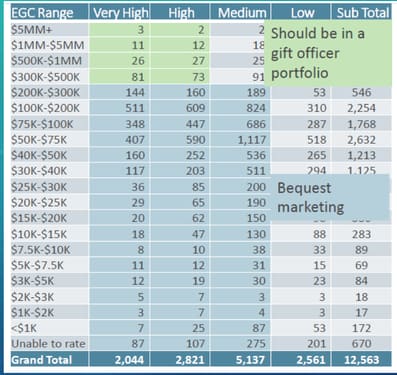
Our last post gave an overview of how to apply some simple segmentation techniques to your database with a focus on starting or building a planned giving program. We touched on the notion of “RFM” or a measurement of a donor’s recency of giving, frequency of giving, and how much they are giving.
If you haven’t had your database screened, or your screening vendor doesn’t provide a total RFM figure, you can, with a little work, do it yourself. Here’s how.
Easy Steps to Segment Your Donor Database to Optimize Planned Giving
CAVEAT: before doing this, remove any existing planned givers from this exercise.
- Export your data into Microsoft Excel
- Rank all constituents by Recency (limit to five years of giving history).
- Divide the total by 5 – this will give you the number of records to score in each “quintile” or 1/5th of the file
- Assign the top 1/5th – those who have given most recently – the number “5” or the designation “Very High”
- Continue assigning each quarter of the file a number until you get to the final 1/5th with the most distant gift date and assign these the number “1” or the designation “Very Low”
- Repeat these steps by ranking all records for Frequency (number of gifts in a five-year period – excluding pledge payments, monthly credit card payments, and other anomalies)
- Repeat these steps for Monetary represented by the total giving (again, over a five-year period).
- When you have three columns (Recency, Frequency, Monetary), then name a column “Total RFM Score,” and add up the individual scores from the R, F, and M columns. This is your Total RFM Score
You can then cross-tab by giving capacity and RFM to create a reasonable predictive guide to your very best planned giving candidates.
Use the Same Technique to Boost Your Annual Fund
To boost your annual fund results, you can also easily use RFM as a proxy for the likelihood to make another gift. Marketing firms do this all the time to determine which buyers are more likely to buy again. Why not take a page from the for-profit marketing pros and utilize the power of RFM similarly? In other words, donors with the highest RFM are the most likely to both give again and increase the amount of their gift.
What about LYBUNTS? LYBUNTS are donors who gave in the last year but haven’t given again in the current year. LYBUNTS are much more likely to give than a lapsed donor who hasn’t given in five years, so don’t neglect LYBUNT donors!
Here’s an example of what a potentially segmented file of wealth screening results could look like.
If your development team has major gift officers, the group in the green-shaded columns should be moved into their portfolios if the prospect isn’t already under management. The rest, shaded in blue, are optimal for the annual fund, as well as being cultivated for a planned gift in the future.

Want to learn more about do-it-yourself analytics? Contact us today to find out more.

Leave a Reply